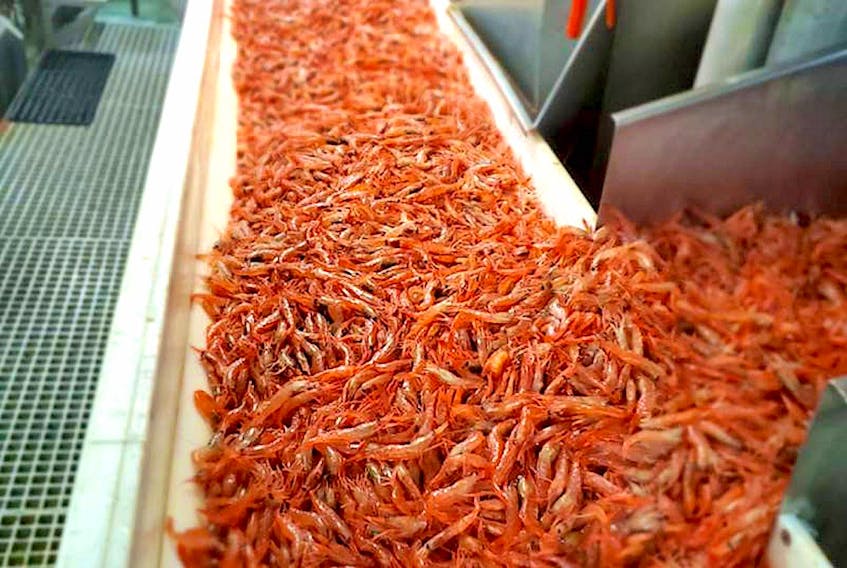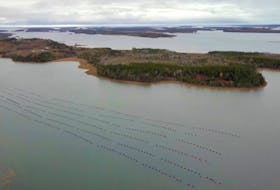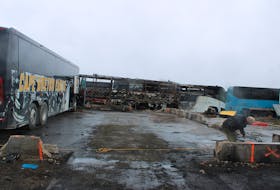The latest research on northern shrimp stocks in Newfoundland and Labrador shows not much has changed from last year.
The biomass in Shrimp Fishing Area (SFA) 6 remains in the critical zone, while the SFA 4 stock is considered to be in the cautious zone and the biomass in SFA 5 is considered healthy.
“Despite fluctuations over the years, stock abundance in SFAs 4 and 6 have been low in the last several years,” Fisheries and Oceans shrimp biologist Katherine Skanes told media in a briefing Thursday morning via Zoom.

The biomass is the total number of male and female shrimp in the area.
In areas 4 and 5, the total biomass estimate is 58,900 and 80,400 metric tonnes respectively.
The spawning stock biomass in Area 4, however, is just 43,100 tonnes and that’s one of the lowest levels since 2004, said Skanes. Using the DFO Precautionary Approach (PA) framework, that stock would be considered to be in the cautious zone.
Area 5 shrimp is considered to be healthy because the spawning stock biomass (51,300 tonnes) and fishable biomass (80,400 tonnes) is slightly higher than the previous year, and not significantly lower than any previous year.
While Area 6 has the largest biomass, at 118,000 metric tonnes, it’s considered to be in the critical zone because that’s the lowest the biomass has been since 1995.
The spawning stock biomass in Area 6 is at 74,800 metric tonnes, which is also the lowest it’s been since its previous low point of about 200,000 tonnes in the mid-1990s.
Under DFO’s PA guidelines, commercial fishing efforts of critical stocks should be no higher than 10 per cent of fishable biomass, Skanes explained, keeping removals moderate when stocks are healthy, promoting rebuilding when stocks are low, and ensuring low risk of harm to the stocks.
“The precautionary approach requires that commercial removals be kept at levels that encourage a stock to remain in or return to the healthy zone,” Skanes said.
Union wants more from Area 6
However, at least one interest group is calling on DFO to increase fishing quotas in fishing area 6.
According to the Fish Food and Allied Workers’ (FFAW) the shrimp biomass in that zone, which extends from Twillingate in Newfoundland to Cartwright in Labrador, increased by 42 per cent.
That’s the main fishing area for inshore fleets.
The inshore boats get about 70 per cent of the total quota thanks to a sharing arrangement established in 2016.
FFAW president Keith Sullivan, in a press release following a technical briefing from DFO, said the union is hopeful that quotas will increase in SFA 6 this year.
“The northern shrimp stock remains very important to many of our members and the assessment shows generally positive signs of growth and stability,” Sullivan said.

“Inshore harvesters remain concerned that exploitation rates remain higher in more northern stock areas, SFAs 5 and 6, where offshore companies have primary access despite there being lower biomass levels than in SFA 6,” he added.
Under the current Precautionary Approach, however, the shrimp stock in SFA 6 has quite a way to go to reach healthy status.
In 2020, the female spawning stock biomass was calculated at 74,000 tonnes.
To move to cautious, the spawning stock would have to grow to 81,600 metric tonnes, explained Skanes.
Healthy designation, she added, “would start at 218,000 tonnes of female shrimp.”
That’s about double the current numbers.
Look at SFA 7
The union also thinks there should be a reassessment of shrimp stock in SFA 7, an area that has been closed to fishing since 2015.
“We certainly want to see additional work done in SFA 7,” said Nelson Bussey, FFAW-executive board member and chair of the 3L fleet committee.
“We have put in a request with DFO every year since 2015 for an experiential fishery to see what’s going on and it is always rejected,” said Bussey. “We believe that this area may again be able to support an inshore fishery.”
Canada is not the only manager involved in area 7.
Skanes notes SFA 7 straddles the 200-mile limit and is assessed annually by the Northwest Atlantic Fisheries Organization (NAFO).
“The last assessment for that stock was done in November of 2020 and at that time there was no sign of improvement in that stock,” she said.
The union also says there’s need to reassess the criteria for precautionary approach.
Skanes said DFO scientists are actively researching a way to establish a new precautionary approach, in all fishing areas.
“However, until that research is completed, the precautionary approach we have established will stand,” she said.
Some of the factors at play on shrimp stocks include fishing, as well as natural mortality and environmental conditions.
“Since 2017 there’s been warmer than average bottom temperatures off the coast of Newfoundland,” Skanes said, “and … since 2015 zooplankton blooms — the things shrimp feed on during larvae stages — have been earlier.”
Science is still trying to determine what impact this might have on the stock.
For now, however, the next step is to decide how much fishing can be allowed.
The Northern Shrimp Advisory Committee (NSAC), involving DFO science, academia, the FFAW and industry interest groups, will meet March 9 to discuss the science and debate quotas for 2021.
The recommendations of the NSAC will then land on the desk of Fisheries and Oceans minister Bernadette Jordan, who will make the final decision on quotas for the 2020-21 fishing season, which begins in April.









